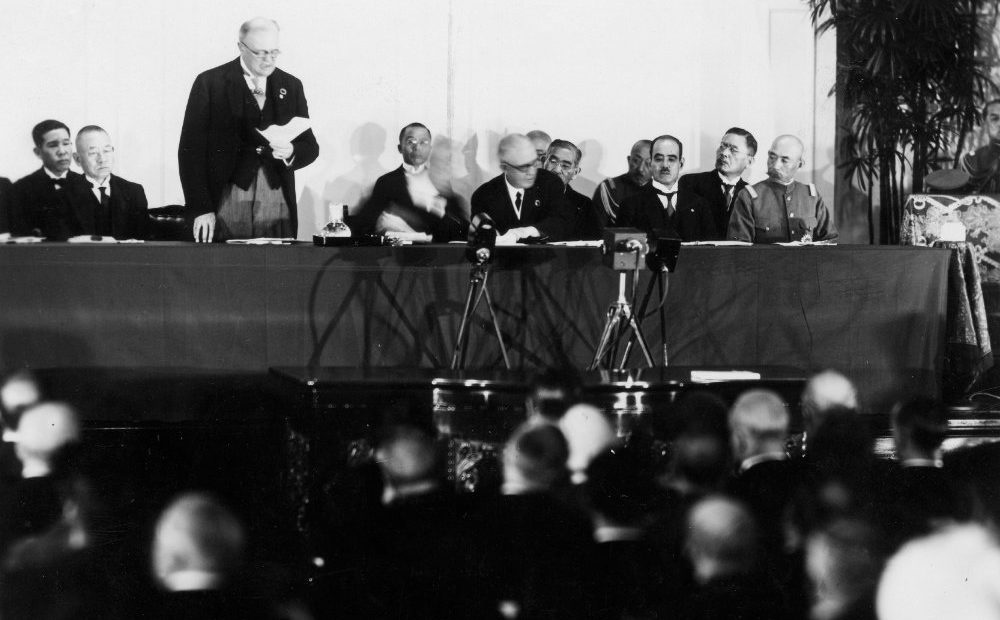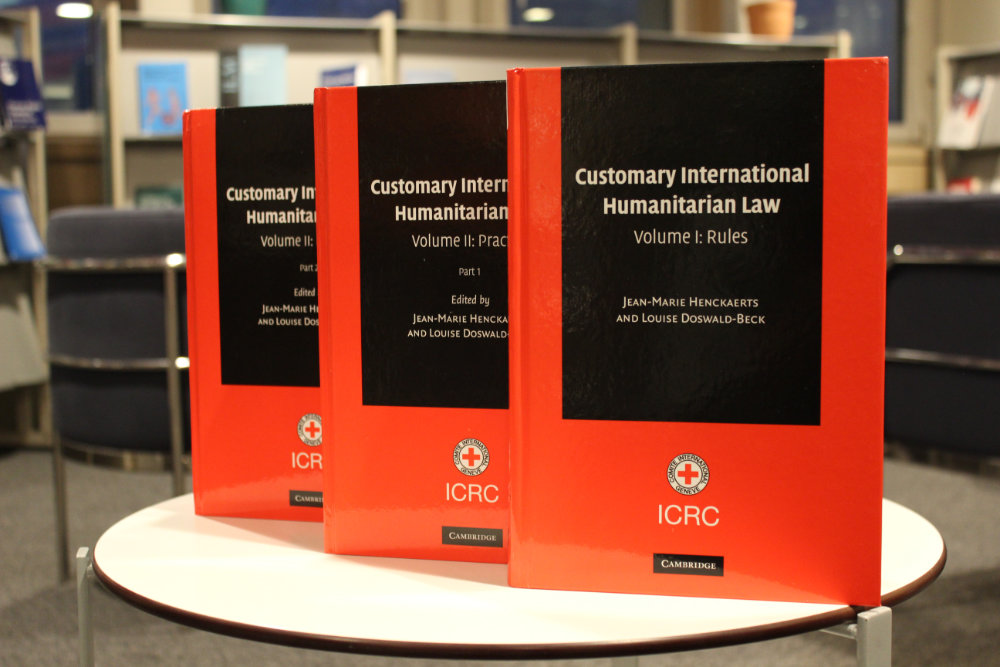The 34th International Conference of the Red Cross and Red Crescent will take place 28-31 October 2024 in Geneva, Switzerland. At this meeting, states party to the 1949 Geneva Conventions and the components of the International Red Cross and Red Crescent Movement will meet to discuss humanitarian issues under this International Conference’s theme “Navigate uncertainty, strengthen humanity”.
In the lead-up to this meeting, ICRC Legal Adviser Ellen Policinski looks back at the role of the International Conference in drafting the 1949 Geneva Conventions, in particular the Fourth Geneva Convention, which protects civilians.
Unsurprisingly, the history of the drafting of the Geneva Conventions has been extensively explored; the contributions of the International Conference of the Red Cross and Red Crescent, however, are perhaps a lesser-known area, and one worth highlighting. As Philippe Abplanalp remarks in his survey on its role in forming the Geneva Conventions, the International Conference has, since the 1800s, endorsed drafts revising the Geneva Conventions and made recommendations to the Diplomatic Conferences that would be recalled to finalize and adopt these core humanitarian treaties.
While updating the ICRC’s Commentary on the Fourth Geneva Convention of 1949, my colleagues and I necessarily spend a lot of time reading the reports and proceedings of past editions of the International Conference and are acutely aware of how important it has been to the formation of the Geneva Conventions as we know them today.
The International Conference takes place every four years and gathers together the International Red Cross and Red Crescent Movement and states party to the 1949 Geneva Conventions. Since 1867, it has served as a global forum to enhance and inspire humanitarian debates among governments, policy makers and the components of the International Red Cross and Red Crescent Movement, which is made up of the International Committee of the Red Cross, the International Federation of Red Cross and Red Crescent Societies, and the 192 National Red Cross and Red Crescent Societies, which are auxiliaries to their government. Initially it took place in a different city each time. In recent times, however, it takes place in Geneva, Switzerland. The International Conference provides an important platform for debate on humanitarian issues. As such, it “has been and still is a forum for dialogue on the implementation of and respect” for international humanitarian law (IHL).
Each International Conference issues formal decisions known as Resolutions, many of which concern IHL. Participants can also make commitments in the form of pledges, either individually or jointly. The Resolutions adopted by an International Conference, including Resolution XIX of the 1948 International Conference in Stockholm, which initiated the formal negotiations of the 1949 Geneva Conventions, are formulated in partnership with government representatives, which is “conducive to their eventual adoption by governments.”
In 2024, the year of the 75th anniversary of the 1949 Geneva Conventions and with the 34th International Conference of the Red Cross and Red Crescent just around the corner, it is an opportune moment to highlight some of the important contributions of the International Conference to the formation of the Geneva Conventions, and in particular the Fourth Geneva Convention protecting civilians.
From Tokyo to Geneva: the International Conference and the protection of civilians
While the International Conference has played a role in each iteration of the Geneva Conventions since the very first one concluded in 1864, it is perhaps most interesting to focus on its role in the formation of the four Geneva Conventions of 1949.
One of several innovations of the 1949 Geneva Conventions was the addition of the Geneva Convention relative to the Protection of Civilian Persons in Time of War, known as the Fourth Geneva Convention. It was a long road to incorporate these protections for civilians in the Geneva Conventions, and one wherein the International Conference played a vital role.
During the First World War, it was already clear that thousands of civilians were not adequately protected by the Geneva Convention of 1906. The ICRC and others had noted the lack of legal protections for civilians in the face of total war.
When the Geneva Conventions on the Wounded and Sick and on the Treatment of Prisoners of War were adopted in 1929, the Diplomatic Conference recommended that “an exhaustive study should be made with a view to the conclusion of an international Convention regarding the condition and protection of civilians of enemy nationality in the territory of a belligerent or in territory occupied by a belligerent.”
The ICRC duly studied the question of civilian protection and presented the Draft international Convention concerning the condition and the protection of civilians of enemy nationality in the territory of a belligerent or in a territory occupied by it at the 1934 International Conference in Tokyo. This became known as the “Tokyo Draft”. At the Tokyo Conference, the ICRC “insisted on the urgency of governments calling a Diplomatic Conference” to adopt the Convention (author’s translation). Resolution XXXIX charged the ICRC to undertake measures to ensure the adoption of the Treaty as quickly as possible.
However, four years later, little progress had been made on codifying protections for civilians. In June 1938, the 16th International Conference was held in London. Delegates to the International Conference were welcomed by then-Princess Elizabeth, who was the president of the British Red Cross Society at the time. On the agenda was the “Revision, interpretation and extension of the Geneva Convention”.
At the London Conference, Swiss delegate Camille Gorgé, reporting on behalf of the Legal Commission, gave a rallying-cry for the revision of the existing Geneva Conventions:
“Can we hesitate, when there lie before us the anvil and the hammer with which better instruments can be forged, instruments which may more effectively alleviate suffering and make the hell of war less hellish? I know what your reply will be. We must act, act without undue delay, act without fear of some little disturbance of governmental and parliamentary routine—proceed without delay to the revision of the Conventions which are considered to be necessary and are not yet adequate.”
In response, the International Conference adopted Resolution X: Draft Conventions, which recommended that a Diplomatic Conference be called to revise the 1929 Geneva Convention and the Xth Hague Convention based on drafts discussed at the International Conference, while highlighting the need for a separate Convention dedicated to the civilian population.
Switzerland announced a Diplomatic Conference to negotiate the treaty in June 1939, scheduling it for early 1940. On 1 September 1939, Nazi troops invaded Poland. Any further negotiations on the Tokyo draft or a similar Convention protecting civilians were delayed indefinitely, as states and the Red Cross and Red Crescent Movement turned their attention to the Second World War.
As Basil O’Connor, President of the American Red Cross and Chairman of the League of Red Cross Societies, later observed, speaking after the close of the Second World War:
“Looking back over the accomplishments of the 1938 International Conference in London, one is struck by the foresight that inspired some of the recommendations that were made at that time. One or two of them were almost prophetic in their vision. The realm of pure hypothesis is, perhaps, unproductive. Yet, it is interesting to speculate upon what might have been if, before World War II broke about our heads, the Red Cross had succeeded in gaining world-wide acceptance of a Convention for the protection of civilians in time of war, and if it had strengthened and expanded the Convention for the treatment of prisoners of war.”
The fact that there was no multilateral treaty dedicated to protecting civilians did not mean that efforts to protect civilians were halted. The ICRC successfully negotiated for the 1929 Prisoners of War treaty to be applied by analogy to many civilian prisoners by several of the Parties to the conflict. It also continued to make proposals to codify protections for civilians.
On 15 February 1945, before peace was achieved, the ICRC announced it was preparing to revise the Geneva Conventions to address the horrors seen during the war. Not all these horrors were given equal consideration. As Srinivas Burra and others have observed, the drafters appeared to privilege the European experience of the war, while undervaluing Southeast Asian and other experiences. As van Dijk observes, the Fourth Convention does not cover all the categories of harm seen in the Second World War. He cites political concerns as also driving states in their negotiations as they prepared for future wars.
In September 1947, a Special Commission of National Red Cross and Red Crescent Societies was called to prepare for the upcoming International Conference in Stockholm. At this Special Commission, chaired by the French Red Cross, 13 National Societies, the League of Red Cross and Red Crescent Societies and the ICRC gathered to discuss the draft Conventions in preparation for the coming International Conference, with a view to “extend the benefit of conventions to all categories of the population, in particular to the civilians who had been so cruelly treated during the last war”.
During this Special Commission, representatives of the Danish and Greek Red Cross Societies each presented a separate proposal for an alternate draft Convention protecting civilians. These drafts put more emphasis on the need to ensuring civilian populations in occupied territory had sufficient access to food. These proposed drafts were ultimately not taken forward, although they were given to the ICRC to incorporate into the existing draft of the Convention protecting civilians.
Originally scheduled for 1942 but delayed by the events of the Second World War, the 17th International Conference took place in 1948 in Stockholm. Count Folke Bernadotte, president of the Swedish Red Cross, opened the International Conference saying:
“This is the first time an International Red Cross Conference has been held since the second World War, which in such a devastating manner ravaged both countries and peoples. It is only natural, therefore, that questions of exceedingly great importance will be dealt with here; questions which will have their importance for coming generations, whether, as we hope, countries and people are to live in peaceful relations, or mankind is once again to be compelled to endure the scourge of war.”
The draft revised Conventions were presented and debated in Stockholm, among many other topics to be discussed at the International Conference, which took place from 20 to 30 August 1948. The Conference met Monday through Saturday, taking Sunday 22 August and Sunday 29 August off.
While the first three draft Conventions were updating existing Conventions, the fourth was entirely new. As ICRC President Paul Ruegger highlighted when he addressed the plenary, the Draft Convention for the Protection of Civilians “might well prove as much to the honour of the Red Cross, as the fact of having, in 1864, promoted the idea of the first Geneva Convention.”
The Legal Commission, which debated draft treaties presented by the ICRC, comprised three sub-committees: one on “the problem of civilian populations”, one on the Geneva Convention related to the wounded and sick, and one on the Convention on Prisoners of War. These met between 21-26 August.
The Legal Commission determined that four treaties should be drafted, instead of one general treaty, because “the contingencies which may arise are so diversified that it has sometimes been necessary to retain different wordings for clauses which we consider common to all the conventions.”
The draft Conventions were presented by the Legal Commission after much discussion, and with the understanding that many of the outstanding issues would continue to be debated by the Diplomatic Conference that would ultimately adopt the Conventions. The plenary considered the drafts and Resolution XIX: Draft International Conventions was adopted, endorsing the draft Conventions and making a general recommendation noting that “these Drafts, in particular the new Convention on the Protection of Civilians, correspond to the fundamental aspirations of the peoples of the world and that they define the essential rules for that protection to which every human being is entitled” and calling for a Diplomatic Conference to finalize and adopt the Conventions “at the earliest possible moment.”
Known as the “Stockholm Drafts”, these would form the basis for discussion at the 1949 Diplomatic Conference that adopted the 1949 Geneva Conventions we know today, including the Fourth Convention protecting civilians. The Diplomatic Conference was convened on 21 April 1949 and the Geneva Conventions were formally adopted on 12 August 1949. The negotiations were relatively short for four treaties. This was no doubt due to the preparatory work done by the International Conference at Stockholm, and before.
After 1949: continuing to strengthen legal protections for civilians
The work of the International Conference to provide greater legal protections for civilians did not end with the conclusion of the Fourth Convention. Of course, work remained on fully incorporating the protection of civilians into IHL, which had traditionally focused on sick, wounded and captured combatants.
Notably, the Fourth Geneva Convention protects primarily civilians in the hands of the enemy. At the time, the protection of civilians from the effects of hostilities was considered too political to address. They would have to wait, but their time was coming. In 1957, the ICRC presented Draft Rules for the Limitation of the Dangers incurred by the Civilian Population in Time of War, on the protection of the civilian population from the effects of hostilities at the 19th International Conference of the Red Cross in New Delhi. Resolution XIII from that International Conference encouraged the ICRC to submit the text to states, but ultimately this was a dead end, as it did not get traction. At the 1965 International Conference in Vienna, the ICRC presented a report on The Legal Protection of Civilian Populations against the Dangers of Indiscriminate Warfare, and Resolution XXVIII: Protection of Civilian Populations against the Dangers of Indiscriminate Warfare was adopted.
At the 21st International Conference in Istanbul in 1969, Resolution XIII: Reaffirmation and Development of the laws and customs applicable in armed conflict mandated the ICRC to reflect on the development of IHL. The ICRC complied, and in 1973 at the 22nd International Conference in Tehran it presented two draft additional protocols to the Geneva Conventions, one to apply in international armed conflict and another to apply in non-international armed conflict.
These protocols were eventually adopted by the 1974-1977 Diplomatic Conference on the Reaffirmation and Development of International Humanitarian Law applicable in Armed Conflicts on 8 June 1977. With these Additional Protocols the rules governing hostilities traditionally found in the Hague Conventions of 1899 and 1907 were finally incorporated into the Geneva Conventions, protecting civilians from being the target of an attack and prohibiting indiscriminate attacks.
2024: “Navigate uncertainty, strengthen humanity”
The 34th International Conference of the Red Cross and Red Crescent will take place in Geneva from 28-31 October 2024. Its theme is “Navigate uncertainty, strengthen humanity”. No new IHL treaties will be proposed; the International Conference will focus instead on fostering a culture of respect for existing IHL rules. The IHL Commission will take place on 29 October, meaning the entire day of the Conference will be dedicated to IHL, specifically how to build a universal culture of compliance with IHL, with several thematic discussions and side events taking place throughout the day.
In addition, two draft Resolutions will be presented that have concrete implications for the way IHL is interpreted and applied. The first is titled “Toward a universal culture of compliance with international humanitarian law”; and the second is “Protecting civilians and other protected persons and objects against the potential human cost of ICT activities during armed conflict”. There will also be a booth in the “Humanitarian Village” at the Convention, where tools and resources related to the 1949 Geneva Conventions, and IHL generally, will be available, including the updated ICRC Commentaries on the Geneva Conventions.
Through these draft Resolutions and by making available materials to assist in interpreting and applying IHL, the International Conference is continuing its work to promote legal protections for civilians during armed conflict.
Author’s note: Readers who will attend the 2024 International Conference and who are interested in learning more about the updated Commentaries and in particular the forthcoming updated Commentary on the Fourth Geneva Convention can visit the Humanitarian Village, where there will be a booth staffed by personnel from the ICRC’s Law & Policy department dedicated to tools and resources related to the 1949 Geneva Conventions, and IHL generally, including the updated Commentaries.
See also:
- Ellen Policinski, War’s long legacy: the continued importance of the Geneva Conventions 75 years later, August 8, 2024
- Cordula Droege, War and what we make of the law, July 18, 2024
- Helen Durham, Kosuke Onishi, ‘Act today, shape tomorrow’: the 33rd International Conference, December 10, 2019





